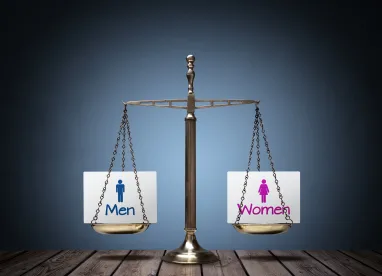Gender equality – the world rankings
Despite having long-established laws requiring male and female employees to receive equal pay for equal work, neither the UK nor the US is close to the top of the global rankings for gender equality. According to the World Economic Forum Global Gender Gap Report for 2017, the UK is in 15th place for gender equality in its society and economy, while the US is 49th on the list of 144 countries.
Iceland takes the top spot for the ninth year in a row, closely followed by the Scandinavian countries. Norway's recent decision to pay its female footballers the same as male counterparts should therefore come as no surprise. What is perhaps surprising is Iceland's commitment to eradicate its gender pay gap altogether by 2022. The latest manifestation of Iceland's determination to remain (arguably) the best place for women to live and work takes the form of the introduction of a law requiring companies that employ 25 or more people to obtain an equal pay certificate annually, by proving that they pay men and women equally. Iceland's ambition is surprising because it is based on an assumption that any gender pay gap is the result of an unacceptable equal pay problem that is either created by, or capable of being resolved by, those who employ the country's working population.
Is pay inequality the cause of the gender pay gap?
In the UK, the Office for National Statistics (ONS) has adopted an experimental statistical analysis to gain an insight into the reasons for the national gender pay gap, currently 18.4% for all employees and 9.1% for full time employees.
The resulting report, appropriately titled "Understanding the gender pay gap in the UK", makes interesting reading for those keen to discover just how far the national gender pay gap reflects factors that can be explained in gender neutral terms. In summary, the ONS concludes that 36% of the gender pay gap can be explained by age, tenure, working pattern, occupation, work region, business size and sector, which means that almost 64% of the UK's national gender pay gap cannot be explained by any of these factors.
The following is of particular interest in the ONS analysis of the gender pay gap in the UK:
- Working pattern - More than 90% of men in their 30s and 40s work full time, compared to around 60% of women. Part time workers are paid less per hour, on average, than full time workers, placing women who work part time at a disadvantage, compared with equivalent male employees
- Occupation – This accounts for 23% of the total pay gap, according to the ONS analysis, ie the vast majority of the 36% that can be explained
- Age - For full time workers below the age of 40 the gender pay gay is relatively small (never more than 2.4%). In older age groups (40 to 60 years and over) the gender pay gap is significantly higher, ranging between 21.8% and 27.2% for all employees and between 10.8 and 18.3% for full time employees. One possible reason for this is childcare. The employment rate for women with dependent children is under 74%, with less than 50% of jobs being full time. The employment rate for men with dependent children is in excess of 92%, with over 90% of jobs being full time
- Tenure – Male full time employees are paid more on average than female full time employees, regardless of their length of service. Interestingly, women who work part time are paid on average more than men who work part time, until they have been employed for five years when men begin to be paid more than women. After 20 years' service women who work part time are paid over 28% less than their male counterparts.
While the above factors may help to explain, in part, the gender pay gap in the UK in gender neutral terms, clearly gender issues do underpin some of the relevant factors. This does not however mean that the 64% of the gender pay gap that cannot be explained by the analysis carried out by the ONS is due to sex discrimination by employers. As the ONS report recognises, factors such as family structures, education, the number of children and other caring responsibilities will also have an impact.
Gender pay gap reporting requirements introduced in the UK
The difficulty encountered by the ONS in seeking to explain the national gender pay gap, despite the wealth of data it has available to it, highlights the nature of the challenge UK employers face in their efforts to understand and report their gender pay gaps in compliance with a new legal requirement.
The publication of gender specific pay and bonus information is about to become a standard annual practice for UK employers with 250 or more employees. By 4 April 2018 (and annually thereafter), private sector employers are required to publish on a Government-sponsored website the following information for their organisation:
- The gender pay gap calculated as both a 'mean' and a 'median' average for the pay period that includes the snapshot date of 5 April (initially 5 April 2017)
- The gender bonus gap, also as both a mean and a median average of bonus payments made in the 12 month period prior to the snapshot date
- The proportions of male and female relevant employees in receipt of a bonus
- The proportions of male and female full pay relevant employees in each pay quartile.
Public sector employers with 250 or more employees are subject to separate regulations that require the publication of the above information by 30 March 2018, based on a snapshot date of 31 March.
Our specialist equal pay team has produced a toolkit to assist with the calculation process and is currently advising a wide range of employers on the analysis of their gender specific pay and bonus information to inform their approach to publication. A recurring theme among clients seeking assistance is a concern regarding the lack of understanding of the difference between 'gender pay' and 'equal pay'.
Equal pay vs gender pay
'Equal pay' involves the entitlement on the part of individual female employees to receive pay that is equal to that of comparable male employees, and vice versa. The position is the same in both the UK and the US.
'Gender pay' is a broader concept that looks at the difference in average rates of pay between male and female employees within an organisation, and on a broader, often national, basis. A gender pay gap may, or may not, be indicative of gender pay inequality as there are many factors that influence rates of pay within an organisation, as the ONS in the UK acknowledges.
The lack of understanding of the difference between equal pay and gender pay becomes a real problem for employers when an organisation's gender pay gap is viewed as indicative of an equal pay problem. The UK Government's introduction of gender pay gap reporting as a means of addressing the gender pay gap, as if it equates to an equal pay problem, sadly adds to the confusion. Of greater concern is that it also creates a real risk that the gender pay gap information that UK employers are now obliged to publicise will be misinterpreted and result in equal pay challenges. The problems such claims create should not be underestimated. Claims for up to six years' back pay that take more than 10 years to resolve can involve eye-watering amounts in financial terms.
As a result, to minimise the risk of an equal pay challenge, UK employers should:
- Ensure they are clear about what is required of them when publishing their gender pay gap results. Potential problem areas include: the correct handling of salary sacrifice schemes; accounting for employees who do not have regular weekly working hours; and confusion regarding the handling of bonus payments as part of the gender pay gap figures
- Publish accurate information. The Financial Times has already 'named and shamed' some employers for publishing obviously inaccurate results (eg all figures as zero). In addition the Equalities and Human Rights Commission has indicated that in enforcing the new law it will focus its attention in the coming year on those employers that fail to publish their results
- Ensure that the reasons for the gender pay gap are understood (as far as possible) by means of the careful collation and analysis of relevant material - including grade, location, pay protection arrangements, and the specific reasons for any pay enhancements or allowances.
Produce a report that puts the figures into context and consider how best to tackle the challenge of explaining the results, taking care to explain the difference between equal pay and gender pay as appropriate.
The increase in the profile of pay as a 'gender issue'
The profile of gender pay and equal pay (often referred to as if interchangeable) is increasing in the UK. The combination of the introduction of the gender pay gap reporting requirements and equal pay claims against a number of major retailers has put gender pay and equal pay issues at the top of the 'to do' list of many UK employers.
Recently the UK press has started highlighting the differences in the reported gender pay gap of companies that operate in the same sector, with significant risk of potential reputational damage for those with the biggest gaps. At the same time, equal pay issues have received unprecedented attention with the backlash against the BBC's recently publicised pay arrangements receiving extensive media coverage.
In the UK, claimants can group together to pursue equal pay claims against the same employer in an employment tribunal, as a form of collective action based on representative claims. Whilst not a 'class action' this mechanism has similar advantages for claimants, as they are able to share the legal cost of pursuing claims.
Status of reporting requirements in the US
The US Equal Pay Act was passed in 1963, and with the exception of an addition to allow coverage to white-collar workers several years later, federal legislation has been limited on the issue of equal pay until 2009, when the Lilly Ledbetter Fair Pay Act became law. The Ledbetter Act provides that each paycheck with allegedly discriminatory pay constitutes a separate violation, thereby extending the time in which an employee has to bring a claim.
Although not legislative action, in 2016, the United States Equal Employment Opportunity Commission, the administrative agency tasked with reviewing complaints of discrimination, used its rule-making authority to revise the scope of the data to be provided to it by certain employers. Prior to issuing the new rule, employers of 100 or more employees or federal contractors with 50 or more employees were required to submit a form EEO-1. This form has historically included data regarding race/ethnicity, sex, and job categories. The proposed, revised form EEO-1 would have expanded significantly to include multiple categories of compensation data and to identify demographic data for multiple “pay bands.”
Unlike the UK’s public reporting requirement, the proposed disclosure by US employers was to have been much narrower. While the new rule significantly expanded the amount of data to be reported to the EEOC, the information would still have been largely confidential to the EEOC . Employers’ EEO-1 reports are generally available to parties other than the specific employer or the EEOC in limited circumstances, including related litigation against the employer. The rule was to have gone into effect 31 March 2018, just days before the UK private sector reporting requirement is set to begin.
However, in August 2017, the US Office of Management and Budget stayed implementation of the rule due to procedural requirements not being met in the process, and concerns that “some aspects of revised collection of information lack practical utility, are unnecessarily burdensome, and do not adequately address privacy and confidentiality issues.”
US employers have been told to submit the existing form for 2018.
It is notable that this pause by the federal government has not resulted in a total halt to addressing and publicizing gender pay inequities in the US. State and local governments have passed their own legislation to attempt to address pay inequities. States, including California and Massachusetts, major cities such as New York City and Philadelphia, and the territory of Puerto Rico have passed laws banning employers from requesting pay histories from applicants . While some measures are subject to litigation regarding constitutionality, these efforts are seen as a way to avoid continuing past pay inequities with new employers. California law takes this effort a step further, and requires an employer to provide an applicant with its pay scale for the position sought upon the applicant’s reasonable request.
Similarly, even predating the proposed rule, some US employers have voluntarily allowed their employees access to compensation data, and this trend is increasing. In some instances, employees are compiling their own compensation data. In 2017, 1200 Google employees compiled their own salary data, which was shared with the New York Times. Although this data clearly does not represent the entirety of Google’s workforce, the New York Times used the data set to identify statistical trends.
However, as in the UK, publicity in the US of gender pay gaps has given the issue more visibility. The US Women’s National Soccer team recently reached a settlement regarding team members’ claims that they were not paid comparably to the Men’s team, despite measurably better competition success. Likewise, Hollywood reports of significant pay disparity between actors and actresses, and the attention generated by the Me Too and Time’s Up movements have placed gender issues in the workplace, specifically, pay disparity, of critical importance to US employers.
Despite the stay in the federal government’s rule-making, individuals or classes with Title VII or EPA claims still have the ability to obtain a significant amount of pay data through the litigation discovery process. Thus, as in the UK, a US employer must maintain accurate records, document reasons for pay determinations, analyse its pay decisions for gender gaps, and to the extent those gaps exist, ensure that the rationale is both non-gender related (eg education, objective performance) and documented.





 />i
/>i
